TU HOC piano
Thursday, June 17, 2021
Hợp âm Rê trưởng (D)
Hợp âm Rê trưởng (D)

Cấu tạo hợp âm Rê trưởng (D)
Bậc 1
Một cách dễ dàng để xác định bậc 1 hợp âm trưởng, đó là tên của hợp âm cũng chính là nốt ở bậc 1. Hợp âm Rê trưởng (D) nên có bậc 1 là Rê (D).
Bậc 3
Bậc 3 của hợp âm Rê trưởng (D) là Fa thăng (F#), cách bậc 1 2 cung.
Bậc 5
Bậc 5 của hợp âm Rê trưởng (D) là La trưởng (A), cách bậc 3 1,5 cung.
Thế đảo hợp âm Rê trưởng (D)


Sunday, June 13, 2021
PIANONANNY
https://www.blogger.com/blog/post/edit/4343061849166841490/3337509957973356407
https://www.blogger.com/blog/post/edit/4343061849166841490/3337509957973356407

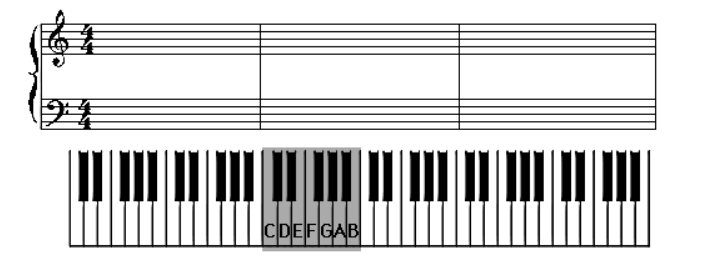
Starter Studies
Lesson 2 - Section 1
Learning About Black Keys
Welcome to lesson number Two. In lesson number one you learned how to find “C” on the piano and to locate middle C. You also learned the other notes on the white keys. Now it’s time to learn about the black keys.
The notes on a piano are divided into Half Steps. Locate middle C. Now move up the keyboard (to your right) to the first black key. The distance between middle C and the first black key is 1 half step. Now move up the keyboard, from the black key, to the next white key (which is “D“). The distance between that black key and “D” is 1 half step.
The reason we are learning this, is to build a foundation for you to learn about Sharps and Flats. The names of the black notes will end with the word sharp or flat.
Now, go to “E” on the keyboard. Move up the keyboard from “E” to “F.” The distance between “E” and “F” is also 1 half step. This can be confusing since you are not moving from a black key to a white key. To clear up the confusion, just remember that any time you are moving from one key to the next (which includes the black keys), you are moving 1 half step.
This is all you need to learn here. The point is to learn how to move 1 half step.

Lesson 2 - Section 2
Learning About Sharps
Now that you have learned half steps you are ready to learn about Sharps.
The word Sharp is like shorthand in typing. It’s a short hand way of saying that you are to move 1 half step up the keyboard.
As an example, go to middle C on the keyboard. Move up to the first black key (1-half step). You are now on the Sharp of “C.” Another way of saying this is that you have Sharped “C.”
Hence, the name of this black note is C Sharp. Now go to “G” and move up 1 half step to the nearest black key. The name of this black key is G Sharp.
Whenever you see the symbol “#” on the staff next to a note, it means that the composer wants you to play a note that is 1 half step up from the note he or she has shown on the staff. Let’s look at how that is written on the staff. Go to the next section.
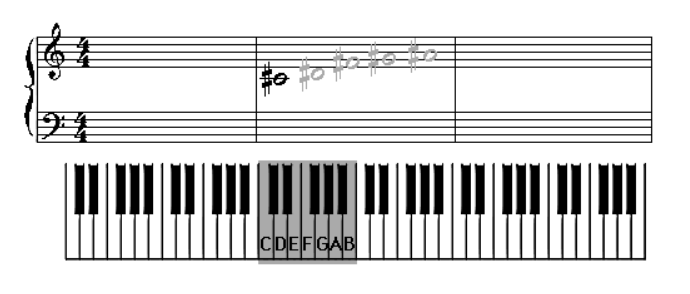
Lesson 2 - Section 3
More About Sharps
Look at middle C on the staff. You’ll notice that it has a “#” sign next to it. This means that the composer wants you to play a note that is 1 half step up the keyboard from “C.”
Go to each white note within 1 octave and locate all the Sharped notes. There are five total (1 for each black note). Their names are:
C# – D# – F# – G# – A#
You are done. Congratulations. You have now mastered Sharps.
Before you go on to the next section, I need to clear up another confusing issue. All the black keys have two names. As you have just learned, they have a Sharp name. In the next section of this lesson, you will learn that they also have a Flat name. Don’t worry. This is not difficult once you see what a Flat is.

Lesson 2- Section 4
Learning About Flats
Now that you have learned Sharps you are ready to learn about Flats. This is the black note’s other name.
The word Flat is also like short hand in typing. It’s a short hand way of saying that you are to move 1 half step down the keyboard.
As an example, go to “E” on the keyboard. Move down (left) to the first black key (1-half step). You are now on the Flat of “E.” Another way of saying this is that you have Flatted “E.”
I think of it as bending the note downward to make the note sound lower or trying to flatten it. And, sharping the note makes the note sound higher.
Hence, the name of this black note is E Flat. Now go to “A” and move down 1 half step to the nearest black key. The name of this black key is A Flat.
Whenever you see the symbol “b” (looks similar to a lowercase b) on the staff next to a note, it means that the composer wants you to play a note that is 1 half step down from the note he or she has shown on the staff. Let’s look at how that is written on the staff. Go to the next section.
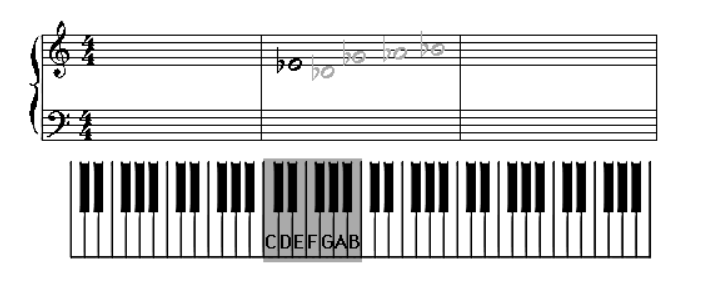
Lesson 2 - Section 5
More About Flats
Look at “E” above middle C on the staff above. You’ll notice that it has a “b” sign next to it. This means that the composer wants you to play a note that is 1 half step down the keyboard from “E.”
Go to each white note within 1 octave and locate all the Flatted notes. There are five total (1 for each black note). Their names are:
Db – Eb – Gb – Ab – Bb
You are done with this lesson. Congratulations! You have now mastered Flats.
Quick Review
“C” Sharp is the same black note as “D” Flat
“D” Sharp is the same black note as “E” Flat
“F” Sharp is the same black note as “G” Flat
“G” Sharp is the same black note as “A” Flat
“A” Sharp is the same black note as “B” Flat
This # symbol stands for Sharp and this b symbol stands for Flat.
Remember to practice at least 15 minutes every other day until you start to play and practice songs. Practice by looking at your keyboard and identifying the name of each note as you play it and hear how it sounds. Also remember that each black note has two names (and some white notes too). How about a quiz to check your progress?
Click or Tap to take Quiz
Saturday, June 12, 2021
Starter Studies Lesson 1 - Section 1[PIANO ON ANY]
https://www.pianonanny.com/page1.html

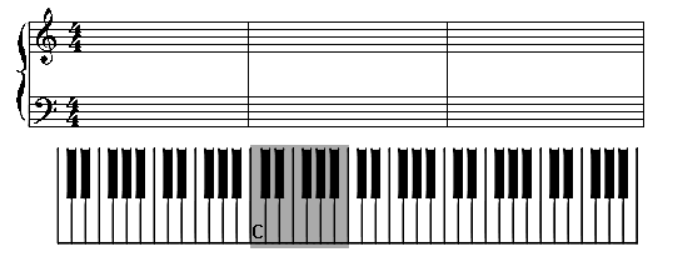
Starter Studies
Lesson 1 - Section 1
Welcome to PianoNanny.com
The images in this tutorial will be minimal so that the loading speed into your browser will be as fast as possible. On a desktop computer, the images display in the right-hand column. On mobile devices, the images display at the bottom of each lesson section. Please note that this course uses HTML 5 embedded mp3 audio files.
Also, you will need to have at least a small portable keyboard in front of you as you go through these lessons so that you can look at it and become familiar with it. Learning a keyboard is like typing. You need a typewriter keyboard in front of you to learn to type. The same is true of the piano. You need a piano keyboard in front of you to learn to play piano. A small Casio or Yamaha portable keyboard with built-in speakers would work just fine.
First Look at the Piano Keyboard
As you first look at the piano keyboard (see image), it looks like there are lots and lots of notes to learn. Not so! You only need to learn 12 notes. The shaded area on the keyboard in the image shows the 12 notes you will need to learn. Notes on a piano are grouped in sets of 12 notes.
Each group has 7 white keys and 5 black keys. Look at the keyboard above and count the 7 white keys and 5 black keys in the shaded area. This is one group. This group is repeated over and over, up the keyboard and down the keyboard. Each group starts with a “C” note. See the note labeled “C” above? On any keyboard, “C” is always the first white key that is to the left of two black keys.
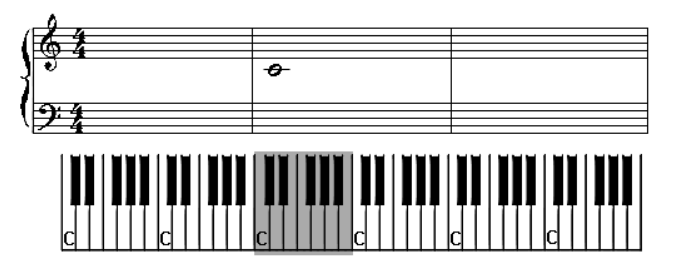
Lesson 1 - Section 2
More "C" Notes
Here are more “C” notes. See how they are all located next to two black notes? Good job. . . you have learned where “C” is on the piano. This is a big step because you will always need to locate “C” before you begin to play a song on the piano.
To make this even easier, you only need to locate one “C.” This special “C” is called middle C. It’s called middle C because, when you sit down at the piano to play, it is the “C” that is straight in front of you and in the middle of the keyboard. Look at the picture of the keyboard again. You will see some lines, symbols, and numbers. This is called a Staff. Middle C is also in the middle of the Staff.
The Staff is Where the Language of Music is Written
The Staff is where the language of music is written. Yes, music is a language just like any other (English, French, Spanish). It has rules and special characters and so forth. This language tells you what to play and where to play it on your instrument. There is only 1 note currently shown on the staff above (the circle with a line through it). This note is middle C. Let’s learn some more notes on the staff and how they relate to the piano keyboard.
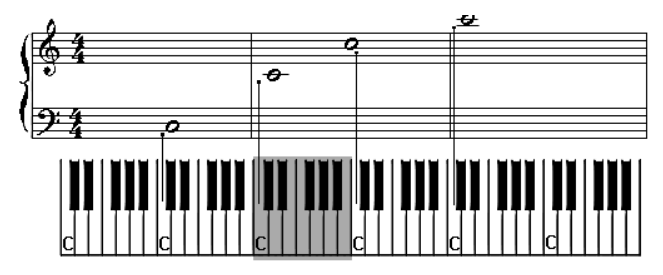
Lesson 1 - Section 3
How "C" Notes Look on the Staff
Here are some other “C” notes and how they look when they are written on the staff. See middle C in the shaded area? Go to the right and look at the next “C” above middle C. Now go to the left and look at the next “C” below middle C.
Count the keys on the keyboard (including the black keys) and you will find that there are 12 keys (notes) between each “C” on the keyboard. On the Staff, above the keyboard, count the lines and spaces between two “C” notes and you will find that there are a total of 8 lines and spaces between two “C” notes.
Learning About Octaves
This spacing of 12 half steps (includes white and black notes) on the keyboard or 8 (includes lines and spaces) on the staff, is called an Octave. In the image, you are looking at Octaves on the staff and on the keyboard, (from one “C” note to the next “C” note). You will eventually learn all the notes in 1 octave. The octave we will concentrate on will include middle C.
For now, go ahead and find all the “C” notes you can on your keyboard.
NOTE: Keyboards come in different widths so don’t worry if you end up with more or less “C” notes than the keyboard shown in the image. Look for two black keys and then the first white key to the left of these black keys. This white key will always be a “C” note.
Now that you’ve mastered “C” notes, it’s time to learn the other 11 notes in 1 octave.
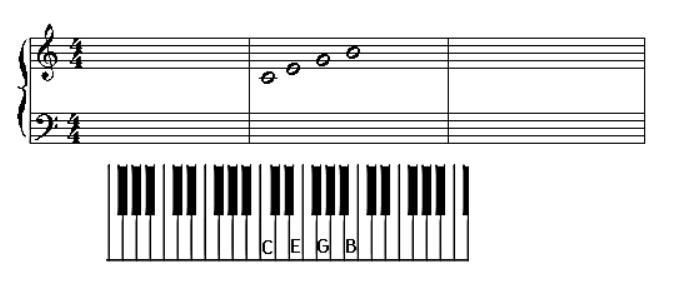
Lesson 1 - Section 4
Notes Written on Lines
Let’s start with the lines on the staff above. The notes that are written on the lines in the staff are “C,” “E,” “G” and “B“. You can make up a fun sentence to help remember the names of the notes that are written on the lines in the staff. Example: Cows Eat Glue Buckets. Make up one for yourself and write it down somewhere. Keep it close to your keyboard for reference.
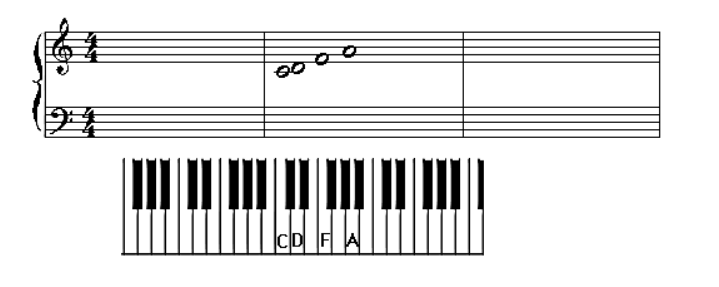
Lesson 1 - Section 5
Notes Written on Spaces
Now let’s look at the spaces on the staff. I’ll leave the “C” note in just for reference only. It is not on a space. The notes that are written on the spaces in the staff are “D,” “F” and “A“. You can make up a fun sentence to help remember the names of the notes that are written on the spaces in the staff. Example: Dogs Find Apples. Make up one for yourself and write it down somewhere. Keep it close to your keyboard for reference.
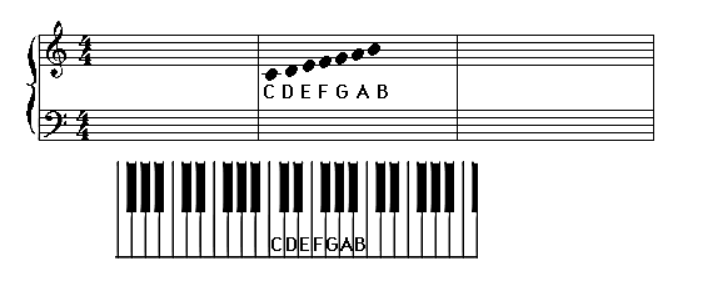
Lesson 1 - Section 6
Congratulations!
Give yourself a pat on the back and a final look at the notes you’ve learned today. You have now mastered the white notes on a keyboard. Next we will learn the black notes. Both white and black notes are important to learn if you are intent on learning to play the piano in more than one key. For now, look over this lesson and play these notes on your keyboard. Say each note in your head as you play it. Practice. No one learned anything without practice. Now how about taking a short quiz to test yourself?
Monday, June 7, 2021
TU HOC PIANO yamaha
https://tuhocdanpiano.com/tu-hoc-piano/
TỰ HỌC PIANO
Tổng hợp các bài hướng dẫn \
cách tự học đàn piano, các bài học đi từ cơ bản theo lộ trình cho người mới học giúp bạn tự tập đánh đàn piano tại nhà. Những bài học đơn giản dễ hiểu giúp bạn định hình cách học và đánh đàn piano để chơi được những bài nhạc nhẹ lâu nay yêu thích.
-
Cách đọc nốt nhạc piano cho người mới học nhạc × ĐĂNG KÝ HỌC THỬ Trải nghiệm các khóa học thú vị tại Trường Âm Nhạc Yamaha *Áp dụng tính phí...






